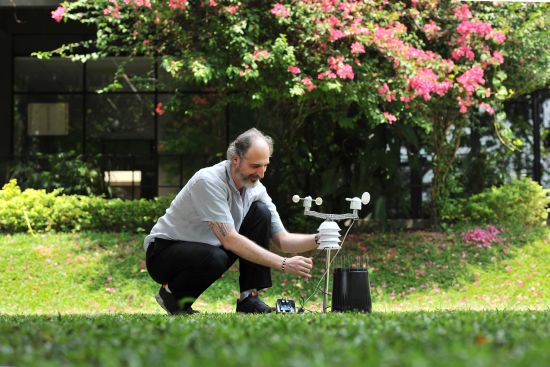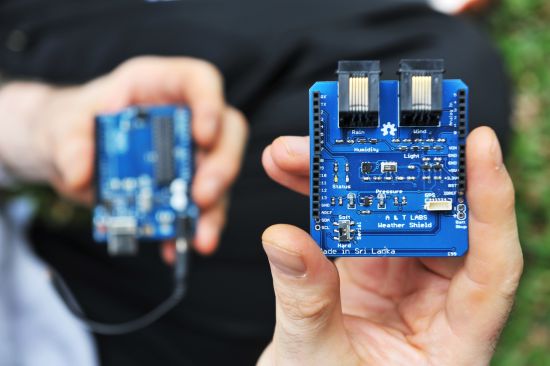New, low-cost and portable weather stations could help countries like Sri Lanka better prepare for floods and landslides.
The stations are designed to capture and transmit near real-time data on rainfall, helping raise the alarm when rains reach a certain level of intensity.
They are being developed as open-source products, meaning the designs will be freely available online for anyone to use.

Sri Lanka regularly experiences extreme variations in weather – especially rainfall – over short distances. Downpours can be sudden and intense in one area, while nearby it’s bone dry. This makes it very difficult to accurately predict natural hazards like floods and landslides, which cause significant destruction and loss of life in the country each year. Increasing the number of weather stations could help give a clearer idea when and where rainfall is reaching dangerous levels.
But for this to work effectively, many weather stations are needed. At around USD$10,000 per station, standard devices certified by the World Meteorological Organizaton (WMO) can be prohibitively expensive. They also contain precision instruments for measuring additional variables like temperature and solar radiation. These stations can be difficult to maintain, and often have a relatively short lifespan.
The new devices, known simply as Mobile Weather Stations, are made primarily from locally sourced materials, and cost around USD$250. While they currently lack the very high level of accuracy required for official WMO certification, they still provide useful information for scientists, farmers and disaster management officials.
Why new devices could set alarm bells ringing in the rain
[pullquote type=”pullquote3″ content=”What we’re doing is completely fundamental to get to the next generation of climate monitoring. It gives us so many possibilities.” quote_icon=”yes” align=”right”]What we’re doing is completely fundamental to get to the next generation of climate monitoring. It gives us so many possibilities.[/pullquote]
The devices were designed by IWMI scientist Yann Chemin, who had the idea during a visit to Sri Lanka’s southern coast.
“It was a hot, sunny day; there wasn’t a single cloud in the sky, and I was trying to protect myself from getting cooked like a lobster,” he said. “But when I checked the weather using an app on my phone, it told me it was cloudy and raining. It was completely inaccurate.”
For Chemin, the solution was relatively simple: increase the number of weather stations on the island to improve the accuracy of weather reporting. The implications could be enormous – from more useful traffic announcements on the radio to better advance warning systems for floods.
But then he ran into the problem of cost.
“The expensive weather stations measure many variables, but in Sri Lanka, what’s really important to know on a local scale is the intensity of rainfall. With this information you can do so many things – even if it comes with a larger-than-usual margin for error. So rainfall information is the most important data captured by the Mobile Weather Stations, and while they are not as precise as the WMO-certified devices, they are as accurate as we need them to be.”
The new Mobile Weather Stations are equipped with an atomic clock to give precise time and date readings, and a GPS sensor, which updates automatically if they are moved. Chemin is devising a system for connecting them to Sri Lanka’s mobile phone network to transfer the data.
Eventually, there could be hundreds of weather stations set up around the country, sending information into a central database. In the event of heavy rains, automated SMS alerts could be sent to people living in areas at risk of landslides. Similar warnings could be sent to those in charge of the country’s many irrigation reservoirs, known locally as ‘tanks’.
“It would give the tank managers advance warning to prepare for higher-than-usual flows of water into the tank system,” continues Chemin. “They could take action to release water elsewhere along the network to that the system doesn’t become overwhelmed and flood. There’s no rocket science in that; by capturing and sharing the information quickly, we’re simply giving people much more time to act.”
Locally made for local use
A central principle in the design of the Mobile Weather Stations is that they are cheap to produce and made from parts that are easy to source and replace.
Chemin says around 80% of the components can be produced in Sri Lanka.
He built the first prototype with the majority of components purchased in Pettah, a district of the capital Colombo. Only the sensors need to be imported, together with the plastic housing, which he bought on the online auction site eBay.

The circuit boards were produced by a new electronics company in Colombo, while local blacksmiths can easily make the metal stands for the devices to rest on.
The stations are powered by a single solar panel, connected to a standard motorbike battery and charger. According to Chemin, this means “any electrician can fix anything that goes wrong with the power system.”
There are currently three Mobile Weather Stations being trialed in the north of the country, and the Meteorological Department of Sri Lanka is due to test a fourth at its headquarters in Colombo. A further 10 devices are being produced in conjunction with the Lanka Rainwater Harvesting Forum, a long term partner of IWMI. The Forum hopes to use the devices in the country’s Dry Zone, to improve rainwater harvesting in villages affected by CKDu (Chronic Kidney Disease of unknown etiology), which may be linked to drinking contaminated groundwater.
By making all the designs open-source, more people can build their own weather stations and share improvements or refinements. For Chemin, this is critical to the success of the idea.
“What is essential is the ‘community of learning’ that we have created by making these designs open-source,” he continues. “We are not aiming to deliver a product; we’re giving the power of customization to people. It puts everyone on an equal footing, and you all learn together and build up trust. By building trust, we all grow better.”
“What we’re doing is completely fundamental to get to the next generation of climate monitoring. It gives us so many possibilities.”
This work was funded by the CGIAR Research Program on Water Land and Ecosystems and the CGIAR Research Program on Climate Change, Agricluture and Food Security

